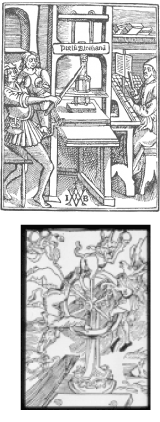

Home | Course Information | Course Projects | Student's Work |
The Invention
Letter Form Project | The Printing Press | TypeStyles | History of Type | Letter Archetecture
| The Invention In the Mid-15th Century, things begin to change with the advent of the printing press. In 1452, Gutenberg conceives of the idea for movable type. In his workshop, he brings together the technologies of paper, oil-based ink and the wine-press to print books. The printing press is not a single invention. It is the aggregation in one place, of technologies known for centuries before Gutenberg. His contribution to printing was the development of a punch and mold system which allowed the mass production of the movable type used to reproduce a page of text. These letters would be put together in a type tray which was then used to print a page of text. If a letter broke down, it could be replaced. When the printing of the copies of one page was finished, the type could be reused for the next page or the next book. The first books to show up in print shops were bibles and religious text. The next books to attract publishers were the poems and history and other texts of antiquity, which were brought back from Byzantium by the Crusades, but there was little or no printing of new ideas. The use of movable type was a marked improvement on the handwritten manuscript which was the existing method of book production in Europe then. The printing press and movable type revolutionized European book-making. Gutenberg's printing technology spread rapidly throughout Europe and is considered a key factor in the European Renaissance. Gutenberg remains a towering figure in the popular image; in 1999, the A&E Cable Network ranked Gutenberg #1 on their "People of the Millennium" countdown and in 1997, Time–Life magazine picked Gutenberg's invention as the most important of the second millennium. |
 |